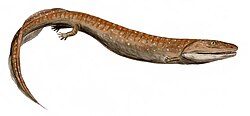| Archichthys Temporal range: Carboniferous | |
|---|---|
| Scientific classification | |
| Domain: | Eukaryota |
| Kingdom: | Animalia |
| Phylum: | Chordata |
| Clade: | Sarcopterygii |
| Clade: | Tetrapodomorpha |
| Class: | † Rhizodontida |
| Order: | † Rhizodontiformes |
| Family: | † Rhizodontidae |
| Genus: | † Archichthys Hancock and Atthey, 1870 |
| Type species | |
| †Archichthys portlockii Portlock, 1843 | |
| Synonyms | |
| |
Archichthys is a genus of rhizodont lobe-finned fish that lived throughout the Carboniferous period. Fossils have been found in Northern Ireland and England. [1]





